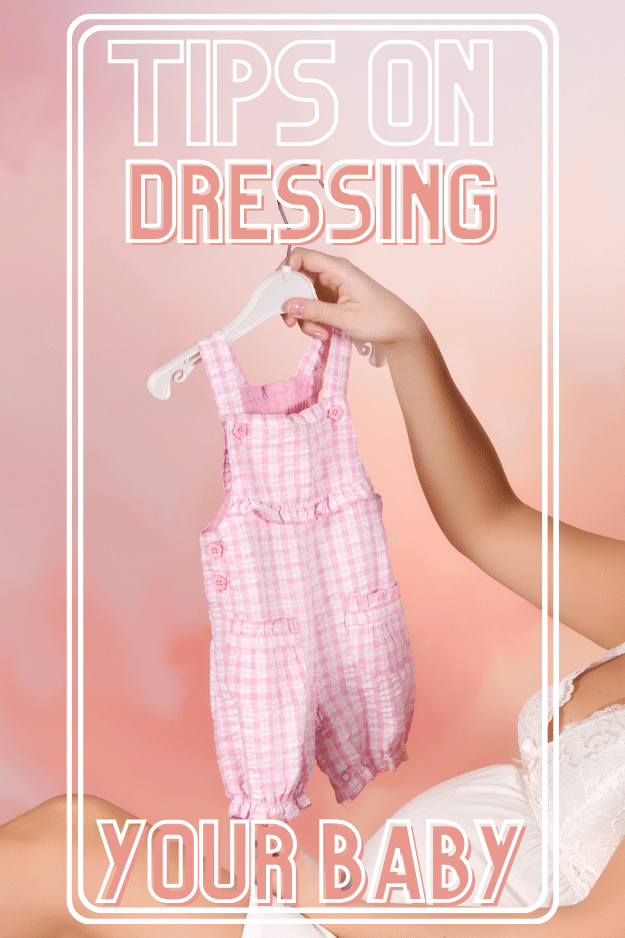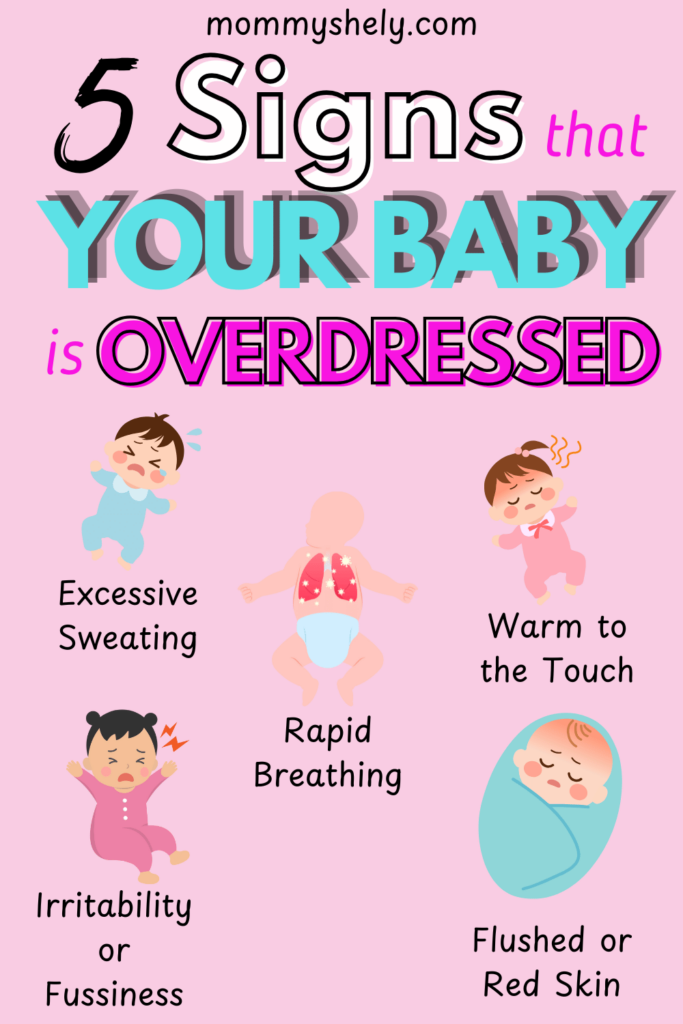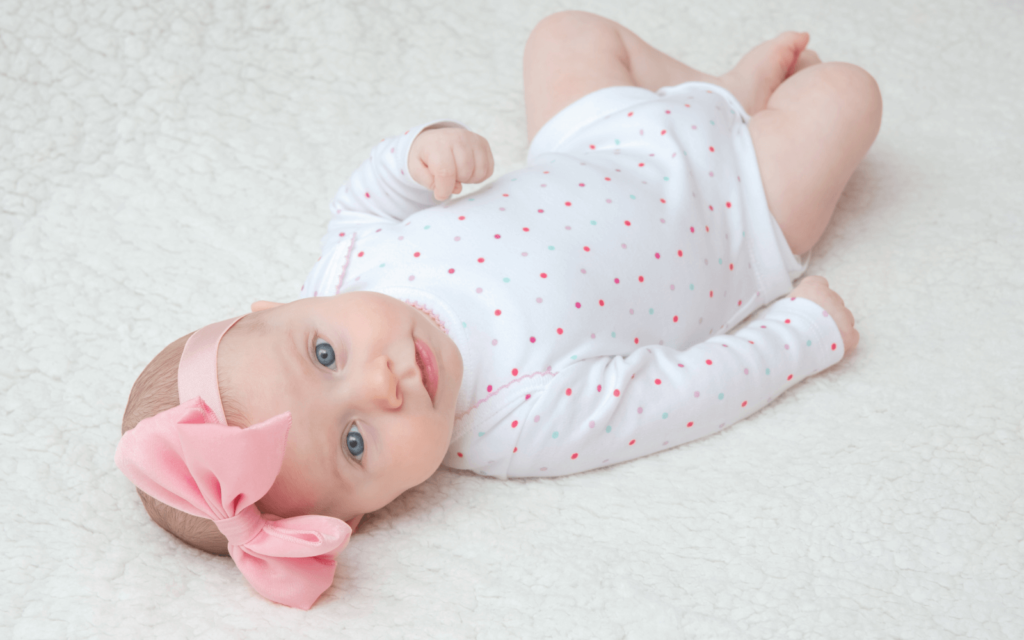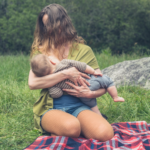Ah, baby clothing… I’m not sure why, but this was one of my main concerns before having my first baby, Liam.
How many clothes do I need to buy? Should I buy size NB or 0-3? Zippers? Snaps?
Liam was born in winter, so that raised some more concerns about how to ensure he stayed warm but not overheated.
My head was spinning from the endless possibilities.
I made many mistakes, but through trial and error, I figured out the best way to choose, care for, and store baby clothes.
Now, I’m sharing my experience so you can avoid the same pitfalls and dress your baby comfortably, safely, and stylishly.
Pin for Later!

As an Amazon Associate I earn from qualifying purchases. This post may contain affiliate links.
How Many Outfits Do You Really Need for a Newborn?
Well, there isn’t one right answer.
On one hand, babies are messy – with spit-ups, blowouts, and snot everywhere. There are days when you’ll have to change them multiple times.
But on the other hand, babies grow quickly, and your little one won’t stay in one size for long.
After buying far too much for Liam (and realizing just how quickly the costs of raising a baby can add up), with Emily, my youngest, I found that the magic number is 18.
I suggest you have about 14 sets of clothes for your newborn, so you have two outfits for each day of the week. Additionally, include 4 extra outfits, including a going-home outfit and some fancy clothes for holidays or events (or for an amateur photoshoot at home).
Now, if your baby has reflux or if they have a big brother who loves touching them with greasy hands, you can always buy a few more outfits along the way.
Dressing Your Baby by Season
How to Dress a Newborn in Winter
In the first 3 months of their lives, newborns struggle to regulate their body temperature. So you need to dress them in layers, regardless of the temperature at the time of their birth.
As I mentioned, Liam was born in winter, and I was stressed out, not knowing how to make sure he wouldn’t get a cold.
According to the American Academy of Pediatrics (AAP), it’s often best to dress your baby in one more layer than you’re wearing. However, I was always cold, and my husband was always hot, so which one of us should I follow?
After a lot of searching and trial and error, I finally found the best method for dressing my baby in winter:
- Long-sleeve bodysuit
- Soft leggings
- Socks
- Footed pajamas
BUT, and this is crucial, I always checked his temperature using this method: Feel your baby’s chest or back of the neck (not hands or feet) and watch for signs of overheating such as sweating, flushed skin, or rapid breathing.

How to Dress a Newborn in Summer
So, guess what?
After learning how to dress my baby in winter, Emily was born in summer. But you know the deal with the second child… I was much more relaxed.
With a 2-year-old at home, we still wanted to enjoy summer and soak up the sun with our newborn. But how can we have summer fun while keeping Emily safe from things like UV exposure and sunburn?
Well, While layers could be helpful, I didn’t want to overdo it, as too many layers could trap heat.
Instead, I packed a light extra layer for temperature changes and removed it if it became too hot. I chose fabrics like organic cotton and bamboo, as they are breathable and help prevent overheating.
And don’t forget the sun hat and sunscreen!

Choosing the Best Baby Clothes
The best clothes are those made from soft, stretchy fabrics that won’t irritate their delicate skin.
I love Bamboo baby clothes, but it’s a bit pricier. So, I invested in bamboo clothes when they grew up, and their clothes lasted a longer period.
If you’re looking for more ways to make your child’s clothes last longer, check out these tips.
Clothes made from cotton are ideal. BUT here’s the ultimate question – snaps or zippers?
You know, I’m all about those zippers! They’re just way more comfortable for me. Especielly during those nighttime diaper changes (and let me tell you, with Liam’s habit of pooping after every feed, they were a lifesaver!).
And if you’re choosing zippers, you gotta get those double-ended ones. They make diaper changes so much easier without leaving your baby’s chest and tummy out in the cold air!
How to Wash Baby Clothes Properly
Well, taking care of your baby’s clothes involves more than just selecting the cutest outfits.
Follow my tips to ensure that your baby’s clothing remains clean, soft, and gentle on their delicate skin:
- Before dressing your baby in new clothes, always wash them first. Newborn skin can react to dyes, chemicals, and residues from manufacturing processes.
- Choose a mild and fragrance-free detergent specially formulated for babies.
- Pay attention to the care labels on your baby’s clothes and follow the manufacturer’s washing instructions.
- Wash your baby’s clothes separately from the rest of the family laundry. Use a dedicated laundry basket or hamper for your baby’s clothes to keep them separate and organized.
- While fabric softeners might make clothes feel soft and smell nice, they can also leave behind residue that could irritate your baby’s skin. So, just skip them – your baby already has that certain je ne sais quoi smell to them.
- Use warm water for washing your baby’s clothes. It helps remove dirt and stains effectively without being too harsh on delicate fabrics. Avoid hot water, as it can cause colors to fade and fabrics to shrink.
- Whenever possible, air dry your baby’s clothes instead of using a dryer. And when using a dryer (because let’s face it, it’s easier), don’t use dryer sheets.

How to Fold Baby Clothes
When I was pregnant with Liam, I stumbled upon a video about folding baby clothes using the KonMari method, and I was hooked.
Since then, it’s the only way I fold their clothes and organize them inside the drawers.
✔ It keeps drawers organized.
✔ It makes finding outfits quick and easy.
Watch a quick tutorial on how to fold baby clothes:
If you opt for a closet instead of drawers, keeping your baby’s clothes organized by size is just as important!
I’ve designed these adorable printable closet dividers to help you separate newborn, 0-3 months, 3-6 months, and beyond!
Download them here for free:
Additional Baby Clothing Tips
How to Literally Dress Your Newborn
Explaining how to dress someone might seem silly, but if you’ve never done it before, it can be tough. Especially with a wiggly baby who might cry because they don’t like it.
What I’m going to share, I learned through trial and error until I found the most efficient way (you’ll thank me when your baby starts rolling).
When it comes to dressing your baby with a bodysuit, there are two common approaches:
Top-to-Bottom Approach: This method begins by scrunching up the bodysuit into a ring of fabric. Then, lay the bodysuit flat under your baby’s head, gently pull it over your baby’s head, guide their hands through the sleeves, and finally pull it down their body before closing the snaps at the bottom.
Bottom-to-Top Approach: In contrast, this approach involves sliding the bodysuit up from your baby’s legs (the snaps can already be closed), pulling it up over their body, and finally guiding their hands through the sleeves and adjusting it around the neck.
The latter was my favorite approach with Emily, who hated covering her face even for a split second.
When it comes to snaps or zippered footed pajamas, I discovered that the most effective way is to open them up and lay them flat under the baby’s body. Then, insert the hands followed by the feet and close them up.
The Blowout Hack
A life saving hack to deal with blowouts is to pull the baby’s clothes down from the shoulders instead of up over their head. Many baby clothes have sort of flaps in the shoulders for this very reason.
This way, you minimize the mess and avoid spreading any mess further. Simply unfasten the clothing at the shoulders and gently pull it downwards, keeping the dirty area contained as much as possible.
For more easy and practical tips for your baby, visit my post 60+ Baby Hacks, Tips and tricks.
Baby Accessories

Some baby accessories like socks and hats are really important, especially when it’s cold outside.
A Sun hat can also protect your baby from the sun if you take them out during the summer (although it’s best to keep them in the shade).
What about mittens? I bought a few because I heard that babies can accidentally scratch themselves, and you can’t trim their nails at first.
That turned out to be true, but after the first day, I didn’t use them much because I used clothes with built-in mittens, that are much more convenient.
As for shoes, they can look cute with some fancy outfits. But in that age, they often end up just sitting in a drawer unused.
If you have a baby girl, ribbons and bows can add a sweet touch, but it’s important to respect your baby’s preferences. Emily didn’t like anything on her head, so I learned to listen to her cues and skip the accessories if they bothered her.
Preemie Baby Clothes
A preemie, which is short for “premature baby,” is a newborn who arrives before 37 weeks of pregnancy. They can weigh 2 to 5 pounds, so regular newborn clothes are usually too big for them.
If you’ve just had a preemie, remember that there are clothes available specifically designed to fit your tiny baby.
Combine Sizes
Buy newborn size or 0-3 size?
Well, I recommend having a combination of both sizes available.
Newborn sizes typically fit babies up to around 8 pounds or so, while 0 to 3 months sizes are designed to fit babies up to around 12 pounds or more.
If your baby is expected to be smaller at birth or if you prefer a snugger fit, newborn sizes might be the better choice.
However, if you want clothes that your baby can grow into and wear for a longer period of time, then 0 to 3 months sizes would be more suitable.
Different brands may have variations in their sizing, so check the baby clothes size chart provided by each brand. For example, Gerber’s newborn size dimensions are around 17-21 inches in length, while Old Navy is 19-23 Inches.
Well, that was my two cents about baby clothing. I hope this post will help you steer clear of the mistakes I made and feel more confident about dressing your baby.
Did you learn something new? Let me know in the comments!
With love,
Shely




Such a well written article. You have certainly answered some questions I had when I had my first child. Both of my children are adults now but I know this article will come in handy for moms everywhere!
Thanks Victoria for the positive feedback 🙂